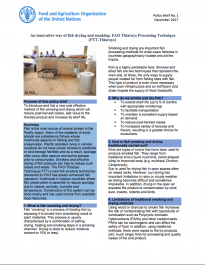Application of Appropriate Technology for Artisanal Fish Smoking
Food loss and waste (FLW) in artisanal fish smoking is associated with a lack of adequate technology. Four technologies are summarized below, which offer potential solutions to FLW: improved smoking kilns, improved packaging, prevention of insect infestation, and other methods.
Improved Smoking Kilns
Improved Smoking Kilns
Traditional smoking kilns or ovens are known to be labour intensive, fuel inefficient, have difficult process control and require constant attention, if the burning of fish is to be avoided. As a result, much attention has been given to the development and introduction of improved fish smoking kilns, which give greater control over the process, save fuel, provide a healthier working environment, and are capable of producing better quality products and hence reduce FLW.
Examples of improved smoking kiln technology include:
- Altona oven
- Chorkor oven
- Watanbe drum smoker
- Ivory Coast Kiln
- Adjetey oven
- FTT Thiaroye kiln
The Thiaroye kiln is used to produce smoked fish products that meet certain food safety requirements related to the level of polycyclic aromatic hydrocarbons (PAHs) content. PAHs is classed as a food safety hazard and failure to meet the required standards of some markets will lead to product rejection and hence FLW. An example from Côte d’Ivoire can be found in this video.
Improved Packaging
Improved Packaging
Breakage of smoked fish occurs after processing due to poor handling, packing and transport. Packaging which prevents breakage will assist in reducing FLW. It is recommended to use rigid containers which contain no more than 15kg of smoked fish. The containers should be lined with clean paper and the smoked fish packed carefully to avoid the product moving during transit.
Preventing Insect Infestation
Preventing Insect Infestation
Good hygienic practice and preventing insect pests from contaminating the smoked fish by using clean packaging, preventative barriers and avoiding cross contamination are important FLW preventative measures. The addition of salt to fish before smoking can also help prevent insect infestation. Insect infestation can also be controlled by subjecting already smoked fish to temperatures high enough to kill insect infestation, for example, during a re-smoking process. The use of insecticides applied directly onto the fish can pose serious health hazards for consumers and processors and should be avoided.
Other Methods
Other Methods
Other traditional preservation methods, such as salting and drying will avoid the risk of burning, produce products which are less prone to breakage as well as reduce the use of fuelwood.
Key Publications
Value-addition and SME's: Raison D'etre and Lessons Learnt This document describes work undertaken in Africa to support small and medium-sized enterprises, and to reduce food waste losses, in regards to fish product. | |
An Innovative Way of Fish Drying and Smoking: FAO Thiaroye Processing Technique Describes the Thiaroye improved smoking kiln as a cost effective method of fish smoking and drying which reduces post-harvest losses and adds value. |
More Resources
More Resources
31 October 2023
05 September 2023













